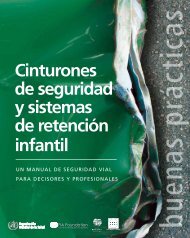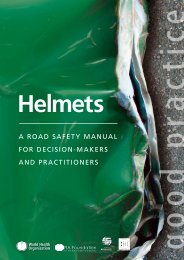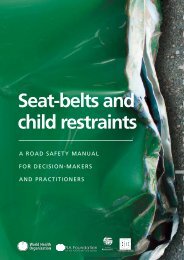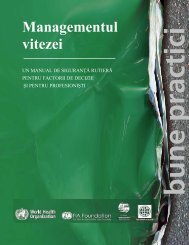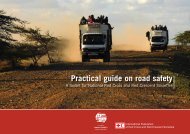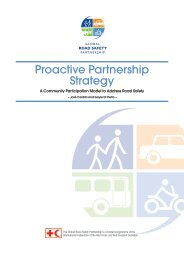How to evaluate the programme - World Health Organization
How to evaluate the programme - World Health Organization
How to evaluate the programme - World Health Organization
You also want an ePaper? Increase the reach of your titles
YUMPU automatically turns print PDFs into web optimized ePapers that Google loves.
Helmets: a road safety manual<br />
common. There is very little published research examining <strong>the</strong> effectiveness of light<br />
weight or locally developed helmets in reducing injury and death in low- and middleincome<br />
countries, particularly with regard <strong>to</strong> mo<strong>to</strong>rcycle helmets. Fur<strong>the</strong>r research in<br />
this area is important as use of such helmets is increasing.<br />
It is possible <strong>to</strong> use routinely collected data <strong>to</strong> calculate head injury and death rates.<br />
<strong>How</strong>ever, <strong>the</strong> efficiency with which such rates can be calculated depends on <strong>the</strong> accuracy<br />
of local surveillance. If <strong>the</strong>re is a uniform capture, coding and reporting system<br />
already set up in hospitals and/or health departments <strong>the</strong>re may be aggregated data<br />
available on head injury, serious head injury or mo<strong>to</strong>rcycle crash-related head injury.<br />
O<strong>the</strong>rwise this may need <strong>to</strong> be abstracted from local data sources. Similarly, mo<strong>to</strong>rcycle<br />
crash and/or death data may be routinely collected from police or transport<br />
authorities.<br />
As quality may be variable, completeness and accuracy of <strong>the</strong>se data sources should<br />
be carefully checked before use.<br />
4 | <strong>How</strong> <strong>to</strong> <strong>evaluate</strong> <strong>the</strong> <strong>programme</strong><br />
Helmet-wearing rates<br />
Ano<strong>the</strong>r appropriate performance indica<strong>to</strong>r is <strong>the</strong> proportion of riders wearing<br />
helmets. Observations of riders may be made at a number of sites before and after a<br />
<strong>programme</strong> <strong>to</strong> document whe<strong>the</strong>r helmet-wearing rates have changed.<br />
Calculating rates<br />
Comparing changes in absolute numbers in injury and death outcomes, or in riders<br />
wearing helmets, before and after a <strong>programme</strong> is not useful, as absolute numbers<br />
may change due <strong>to</strong> an increase or decrease in <strong>the</strong> numbers of riders, registered or o<strong>the</strong>rwise.<br />
It is <strong>the</strong>refore important that rates be calculated. Denomina<strong>to</strong>rs may include<br />
number of riders, registered bikes, or kilometres travelled. For example, for injury<br />
outcomes a rate may be number of injuries per licensed riders, or number of injuries<br />
per 100 000 km ridden. For helmet use, <strong>the</strong> appropriate rate would be <strong>the</strong> proportion<br />
of helmeted riders over <strong>to</strong>tal riders observed. Note that it is preferable <strong>to</strong> use a population<br />
denomina<strong>to</strong>r (e.g. per 100 000 population), ra<strong>the</strong>r than <strong>the</strong> number of mo<strong>to</strong>rcycles<br />
as a denomina<strong>to</strong>r. This is because <strong>the</strong> rapidly increasing use of mo<strong>to</strong>rcycles in<br />
many countries may dis<strong>to</strong>rt <strong>the</strong> results of an evaluation, if this latter measure is used.<br />
Module 2 includes a detailed section on how <strong>to</strong> measure helmet-wearing rates.<br />
4.2.4 Conducting an economic evaluation of a <strong>programme</strong><br />
It may also be necessary <strong>to</strong> conduct an economic evaluation <strong>to</strong> demonstrate ‘value<br />
for money’ and possible cost savings for government by investing in prevention.<br />
Economic evaluation addresses <strong>the</strong> question of whe<strong>the</strong>r one intervention represents a<br />
better use of resources than ano<strong>the</strong>r. In o<strong>the</strong>r words, does spending $x on <strong>programme</strong><br />
A represent a better investment than $y on <strong>programme</strong> B To address this sort of<br />
133



